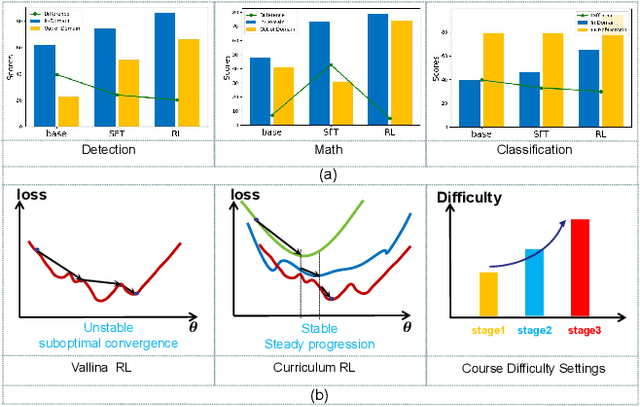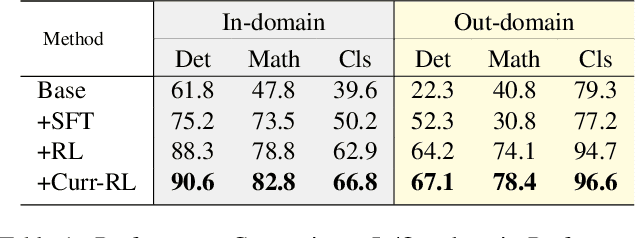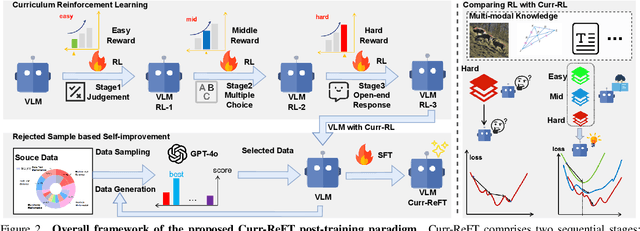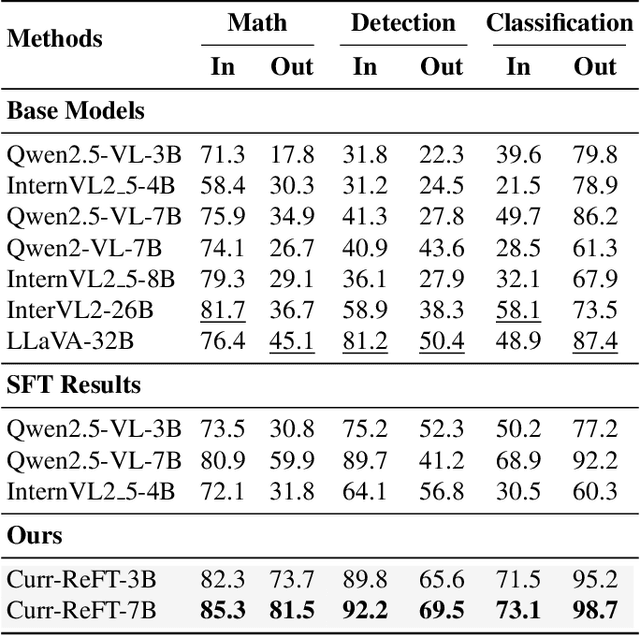Rui Ma
Mitsubishi Electric Research Labs, Cambridge, MA, USA
Stationarity Exploration for Multivariate Time Series Forecasting
Aug 12, 2025Abstract:Deep learning-based time series forecasting has found widespread applications. Recently, converting time series data into the frequency domain for forecasting has become popular for accurately exploring periodic patterns. However, existing methods often cannot effectively explore stationary information from complex intertwined frequency components. In this paper, we propose a simple yet effective Amplitude-Phase Reconstruct Network (APRNet) that models the inter-relationships of amplitude and phase, which prevents the amplitude and phase from being constrained by different physical quantities, thereby decoupling the distinct characteristics of signals for capturing stationary information. Specifically, we represent the multivariate time series input across sequence and channel dimensions, highlighting the correlation between amplitude and phase at multiple interaction frequencies. We propose a novel Kolmogorov-Arnold-Network-based Local Correlation (KLC) module to adaptively fit local functions using univariate functions, enabling more flexible characterization of stationary features across different amplitudes and phases. This significantly enhances the model's capability to capture time-varying patterns. Extensive experiments demonstrate the superiority of our APRNet against the state-of-the-arts (SOTAs).
FreeLoRA: Enabling Training-Free LoRA Fusion for Autoregressive Multi-Subject Personalization
Jul 02, 2025Abstract:Subject-driven image generation plays a crucial role in applications such as virtual try-on and poster design. Existing approaches typically fine-tune pretrained generative models or apply LoRA-based adaptations for individual subjects. However, these methods struggle with multi-subject personalization, as combining independently adapted modules often requires complex re-tuning or joint optimization. We present FreeLoRA, a simple and generalizable framework that enables training-free fusion of subject-specific LoRA modules for multi-subject personalization. Each LoRA module is adapted on a few images of a specific subject using a Full Token Tuning strategy, where it is applied across all tokens in the prompt to encourage weakly supervised token-content alignment. At inference, we adopt Subject-Aware Inference, activating each module only on its corresponding subject tokens. This enables training-free fusion of multiple personalized subjects within a single image, while mitigating overfitting and mutual interference between subjects. Extensive experiments show that FreeLoRA achieves strong performance in both subject fidelity and prompt consistency.
Rethinking Discrete Tokens: Treating Them as Conditions for Continuous Autoregressive Image Synthesis
Jul 02, 2025Abstract:Recent advances in large language models (LLMs) have spurred interests in encoding images as discrete tokens and leveraging autoregressive (AR) frameworks for visual generation. However, the quantization process in AR-based visual generation models inherently introduces information loss that degrades image fidelity. To mitigate this limitation, recent studies have explored to autoregressively predict continuous tokens. Unlike discrete tokens that reside in a structured and bounded space, continuous representations exist in an unbounded, high-dimensional space, making density estimation more challenging and increasing the risk of generating out-of-distribution artifacts. Based on the above findings, this work introduces DisCon (Discrete-Conditioned Continuous Autoregressive Model), a novel framework that reinterprets discrete tokens as conditional signals rather than generation targets. By modeling the conditional probability of continuous representations conditioned on discrete tokens, DisCon circumvents the optimization challenges of continuous token modeling while avoiding the information loss caused by quantization. DisCon achieves a gFID score of 1.38 on ImageNet 256$\times$256 generation, outperforming state-of-the-art autoregressive approaches by a clear margin.
OmniStyle: Filtering High Quality Style Transfer Data at Scale
May 20, 2025Abstract:In this paper, we introduce OmniStyle-1M, a large-scale paired style transfer dataset comprising over one million content-style-stylized image triplets across 1,000 diverse style categories, each enhanced with textual descriptions and instruction prompts. We show that OmniStyle-1M can not only enable efficient and scalable of style transfer models through supervised training but also facilitate precise control over target stylization. Especially, to ensure the quality of the dataset, we introduce OmniFilter, a comprehensive style transfer quality assessment framework, which filters high-quality triplets based on content preservation, style consistency, and aesthetic appeal. Building upon this foundation, we propose OmniStyle, a framework based on the Diffusion Transformer (DiT) architecture designed for high-quality and efficient style transfer. This framework supports both instruction-guided and image-guided style transfer, generating high resolution outputs with exceptional detail. Extensive qualitative and quantitative evaluations demonstrate OmniStyle's superior performance compared to existing approaches, highlighting its efficiency and versatility. OmniStyle-1M and its accompanying methodologies provide a significant contribution to advancing high-quality style transfer, offering a valuable resource for the research community.
BOOTPLACE: Bootstrapped Object Placement with Detection Transformers
Mar 27, 2025Abstract:In this paper, we tackle the copy-paste image-to-image composition problem with a focus on object placement learning. Prior methods have leveraged generative models to reduce the reliance for dense supervision. However, this often limits their capacity to model complex data distributions. Alternatively, transformer networks with a sparse contrastive loss have been explored, but their over-relaxed regularization often leads to imprecise object placement. We introduce BOOTPLACE, a novel paradigm that formulates object placement as a placement-by-detection problem. Our approach begins by identifying suitable regions of interest for object placement. This is achieved by training a specialized detection transformer on object-subtracted backgrounds, enhanced with multi-object supervisions. It then semantically associates each target compositing object with detected regions based on their complementary characteristics. Through a boostrapped training approach applied to randomly object-subtracted images, our model enforces meaningful placements through extensive paired data augmentation. Experimental results on established benchmarks demonstrate BOOTPLACE's superior performance in object repositioning, markedly surpassing state-of-the-art baselines on Cityscapes and OPA datasets with notable improvements in IOU scores. Additional ablation studies further showcase the compositionality and generalizability of our approach, supported by user study evaluations.
Boosting the Generalization and Reasoning of Vision Language Models with Curriculum Reinforcement Learning
Mar 10, 2025



Abstract:While state-of-the-art vision-language models (VLMs) have demonstrated remarkable capabilities in complex visual-text tasks, their success heavily relies on massive model scaling, limiting their practical deployment. Small-scale VLMs offer a more practical alternative but face significant challenges when trained with traditional supervised fine-tuning (SFT), particularly in two aspects: out-of-domain (OOD) generalization and reasoning abilities, which significantly lags behind the contemporary Large language models (LLMs). To address these challenges, we propose Curriculum Reinforcement Finetuning (Curr-ReFT), a novel post-training paradigm specifically designed for small-scale VLMs. Inspired by the success of reinforcement learning in LLMs, Curr-ReFT comprises two sequential stages: (1) Curriculum Reinforcement Learning, which ensures steady progression of model capabilities through difficulty-aware reward design, transitioning from basic visual perception to complex reasoning tasks; and (2) Rejected Sampling-based Self-improvement, which maintains the fundamental capabilities of VLMs through selective learning from high-quality multimodal and language examples. Extensive experiments demonstrate that models trained with Curr-ReFT paradigm achieve state-of-the-art performance across various visual tasks in both in-domain and out-of-domain settings. Moreover, our Curr-ReFT enhanced 3B model matches the performance of 32B-parameter models, demonstrating that efficient training paradigms can effectively bridge the gap between small and large models.
DecoupledGaussian: Object-Scene Decoupling for Physics-Based Interaction
Mar 07, 2025



Abstract:We present DecoupledGaussian, a novel system that decouples static objects from their contacted surfaces captured in-the-wild videos, a key prerequisite for realistic Newtonian-based physical simulations. Unlike prior methods focused on synthetic data or elastic jittering along the contact surface, which prevent objects from fully detaching or moving independently, DecoupledGaussian allows for significant positional changes without being constrained by the initial contacted surface. Recognizing the limitations of current 2D inpainting tools for restoring 3D locations, our approach proposes joint Poisson fields to repair and expand the Gaussians of both objects and contacted scenes after separation. This is complemented by a multi-carve strategy to refine the object's geometry. Our system enables realistic simulations of decoupling motions, collisions, and fractures driven by user-specified impulses, supporting complex interactions within and across multiple scenes. We validate DecoupledGaussian through a comprehensive user study and quantitative benchmarks. This system enhances digital interaction with objects and scenes in real-world environments, benefiting industries such as VR, robotics, and autonomous driving. Our project page is at: https://wangmiaowei.github.io/DecoupledGaussian.github.io/.
Research on visual simultaneous localization and mapping technology based on near infrared light
Mar 04, 2025Abstract:In view of the problems that visual simultaneous localization and mapping (VSLAM) are susceptible to environmental light interference and luminosity inconsistency, the visual simultaneous localization and mapping technology based on near infrared perception (NIR-VSLAM) is proposed. In order to avoid ambient light interference, the near infrared light is innovatively selected as the light source. The luminosity parameter estimation of error energy function, halo factor and exposure time and the light source irradiance correction method are proposed in this paper, which greatly improves the positioning accuracy of Direct Sparse Odometry (DSO). The feasibility of the proposed method in four large scenes is verified, which provides the reference for visual positioning in automatic driving and mobile robot.
SuperNeRF-GAN: A Universal 3D-Consistent Super-Resolution Framework for Efficient and Enhanced 3D-Aware Image Synthesis
Jan 12, 2025



Abstract:Neural volume rendering techniques, such as NeRF, have revolutionized 3D-aware image synthesis by enabling the generation of images of a single scene or object from various camera poses. However, the high computational cost of NeRF presents challenges for synthesizing high-resolution (HR) images. Most existing methods address this issue by leveraging 2D super-resolution, which compromise 3D-consistency. Other methods propose radiance manifolds or two-stage generation to achieve 3D-consistent HR synthesis, yet they are limited to specific synthesis tasks, reducing their universality. To tackle these challenges, we propose SuperNeRF-GAN, a universal framework for 3D-consistent super-resolution. A key highlight of SuperNeRF-GAN is its seamless integration with NeRF-based 3D-aware image synthesis methods and it can simultaneously enhance the resolution of generated images while preserving 3D-consistency and reducing computational cost. Specifically, given a pre-trained generator capable of producing a NeRF representation such as tri-plane, we first perform volume rendering to obtain a low-resolution image with corresponding depth and normal map. Then, we employ a NeRF Super-Resolution module which learns a network to obtain a high-resolution NeRF. Next, we propose a novel Depth-Guided Rendering process which contains three simple yet effective steps, including the construction of a boundary-correct multi-depth map through depth aggregation, a normal-guided depth super-resolution and a depth-guided NeRF rendering. Experimental results demonstrate the superior efficiency, 3D-consistency, and quality of our approach. Additionally, ablation studies confirm the effectiveness of our proposed components.
ZenSVI: An Open-Source Software for the Integrated Acquisition, Processing and Analysis of Street View Imagery Towards Scalable Urban Science
Dec 24, 2024Abstract:Street view imagery (SVI) has been instrumental in many studies in the past decade to understand and characterize street features and the built environment. Researchers across a variety of domains, such as transportation, health, architecture, human perception, and infrastructure have employed different methods to analyze SVI. However, these applications and image-processing procedures have not been standardized, and solutions have been implemented in isolation, often making it difficult for others to reproduce existing work and carry out new research. Using SVI for research requires multiple technical steps: accessing APIs for scalable data collection, preprocessing images to standardize formats, implementing computer vision models for feature extraction, and conducting spatial analysis. These technical requirements create barriers for researchers in urban studies, particularly those without extensive programming experience. We develop ZenSVI, a free and open-source Python package that integrates and implements the entire process of SVI analysis, supporting a wide range of use cases. Its end-to-end pipeline includes downloading SVI from multiple platforms (e.g., Mapillary and KartaView) efficiently, analyzing metadata of SVI, applying computer vision models to extract target features, transforming SVI into different projections (e.g., fish-eye and perspective) and different formats (e.g., depth map and point cloud), visualizing analyses with maps and plots, and exporting outputs to other software tools. We demonstrate its use in Singapore through a case study of data quality assessment and clustering analysis in a streamlined manner. Our software improves the transparency, reproducibility, and scalability of research relying on SVI and supports researchers in conducting urban analyses efficiently. Its modular design facilitates extensions and unlocking new use cases.
 Add to Chrome
Add to Chrome Add to Firefox
Add to Firefox Add to Edge
Add to Edge